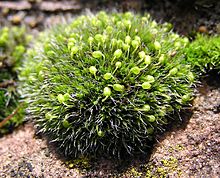



A cryptogam (scientific name Cryptogamae) is a plant (in the wide sense of the word) or a plant-like organism that reproduces by spores, without flowers or seeds.
Taxonomy
The name Cryptogamae (from Ancient Greek κρυπτός (kruptós) 'hidden' and γαμέω (gaméō) 'to marry') means "hidden reproduction", meaning non-seed bearing plants. Other names, such as "thallophytes", "lower plants", and "spore plants" have occasionally been used.
As a group, Cryptogamae are paired with the Phanerogamae or Spermatophyta, the seed plants. At one time, the cryptogams were formally recognised as a group within the plant kingdom. In his system for classification of all known plants and animals, Carl Linnaeus (1707–1778) divided the plant kingdom into 24 classes, one of which was the "Cryptogamia". This included all plants with concealed reproductive organs. He divided Cryptogamia into four orders: Algae, Musci (bryophytes), Filices (ferns), and fungi, but it had also traditionally included slime molds, and Cyanophyta. The classification is now deprecated in Linnaean taxonomy. Cryptogams have been classified into three sub-kingdoms: Thallophyta, Bryophyta, and Pteridophyta.
Not all cryptogams are treated as part of the plant kingdom today; the fungi, in particular, are a separate kingdom, more closely related to animals than plants, while blue-green algae are a phylum of bacteria. Therefore, in contemporary plant systematics, "Cryptogamae" is not a taxonomically coherent group, but is polyphyletic. However, the names of all cryptogams are regulated by the International Code of Nomenclature for algae, fungi, and plants.
In human culture
An apocryphal story: it is said that during World War II, the British Government Code and Cypher School recruited Geoffrey Tandy, a marine biologist expert in cryptogams, to Station X, Bletchley Park, when someone confused these with cryptograms. However, the story is a myth; though Tandy did indeed work at Bletchley, he was not recruited by mistake. At the time the field of cryptography was very new, and so it was typical to hire those with education and expertise in other fields.
References
- Dixon, P. S. (1973). Biology of the Rhodophyta. Oliver and Boyd, Edinburgh. ISBN 0-05-002485-X.
- "Cryptogams". Royal Botanic Garden, Edinburgh. Archived from the original on 2007-11-18. Retrieved 2007-07-02.
- ^ Smith, Gilbert M. (1938). Cryptogamic Botany, Vol. 1. McGraw-Hill.
- Smithies, Sandy (19 January 1999). "Television Tuesday Watching brief". The Guardian. Retrieved 23 July 2015.
- Davies, Mike (20 January 1999). "Cracking the code at last of Station X". Birmingham Post.
- Hanks, Robert (20 January 1999). "Television Review". The Independent.
- Knighton, Andrew (2018-05-27). "The Debunked Yet Interesting Myth About How Seaweed Apparently Helped Break the Enigma Code". warhistoryonline. Retrieved 2024-05-13.
External links
- "Acrogenae" . Encyclopædia Britannica. Vol. 1 (11th ed.). 1911. p. 155.
| Microbiology: Protistology: Protists | |||||||||||||||||||||||||||||||||||||||||||||||||||||||||||||||||
|---|---|---|---|---|---|---|---|---|---|---|---|---|---|---|---|---|---|---|---|---|---|---|---|---|---|---|---|---|---|---|---|---|---|---|---|---|---|---|---|---|---|---|---|---|---|---|---|---|---|---|---|---|---|---|---|---|---|---|---|---|---|---|---|---|---|
| Former classifications | |||||||||||||||||||||||||||||||||||||||||||||||||||||||||||||||||
| Morphology |
| ||||||||||||||||||||||||||||||||||||||||||||||||||||||||||||||||
| Ecology and physiology | |||||||||||||||||||||||||||||||||||||||||||||||||||||||||||||||||
This botany article is a stub. You can help Misplaced Pages by expanding it. |